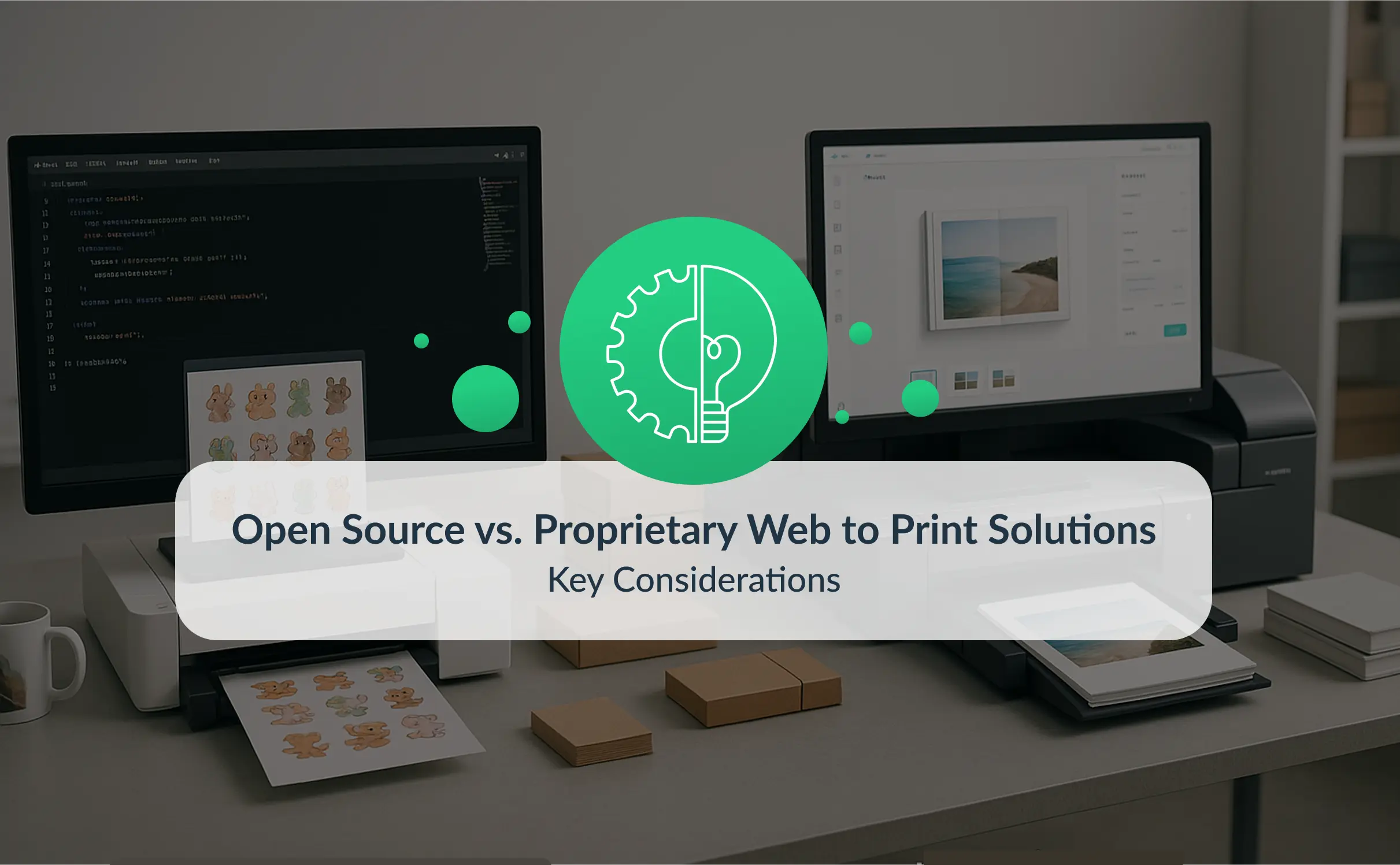In fast-growing personalization businesses, e-commerce teams often face a build-or-buy dilemma when selecting technical infrastructure. Say your product roadmap calls for deep customization options, real-time previews and robust API connectivity. A proprietary platform might get you live faster – but can it keep up long-term without tying your hands? Especially in the web to print storefront open source ecosystem, agility and adaptability are becoming strategic levers, not just nice-to-haves.
Balancing control over your tech stack with time-to-market pressures is tough. But your decision between open-source and closed-source platforms isn’t just operational, but it shapes your business agility for years. We’ll walk you through the trade-offs, use cases and long-term value of each approach.
What is Web to Print?
Web-to-print technology enables customers to personalize, preview and order printed products directly through an e-commerce platform. Think personalized photo books, calendars, canvas prints or branded merchandise – all edited via a browser and processed with minimal manual intervention. For businesses, this means product customization becomes scalable and automated.
Modern web-to-print tools blend frontend UX design (where users modify layouts or photos) with backend logic that ensures print-ready output. But there’s a lot more at stake than just interface design. Your underlying tech stack affects everything from real-time rendering to fulfillment lead times to integration with external platforms.
A web-to-print system typically does three critical jobs:
- Enables product customization via a web interface
- Automates generation of high-quality, print-ready files
- Connects to payment, shipping and production workflows
If you’re selling personalized photo products, it’s often part of a broader e-commerce stack – one that must function seamlessly across marketing, fulfillment and customer service. For a deeper dive into backend technologies that influence production workflows, see our Printing Methods Overview.

Open source Web to Print
Open-source web-to-print platforms offer a high degree of customization and flexibility – but that flexibility is only valuable if your team has the capacity to use it. With access to source code, your developers can build custom features, modify workflows, and integrate tightly with external systems. You’re not boxed into pre-set templates or limited by a vendor’s product roadmap — but this level of control also demands internal expertise and a long-term commitment to maintenance and security.
The term web-to-print open source refers to platforms that are built and maintained publicly, often via developer communities and open innovation ecosystems. Examples include platforms built on PHP frameworks or JavaScript-based design tools, which allow customization across UI and backend logic. These systems benefit from transparency and contributor-driven evolution — adapting faster to market needs.
We’re witnessing a clear movement toward flexible architectures, especially for photo product companies looking to plug into CRM tools, AI personalization engines, or ERP systems. Many companies prioritize integrations through REST APIs and React-based customization layers. This approach aligns with open-source thinking – where interoperability becomes a core principle, not a workaround.
One major benefit? A vibrant plugin and module ecosystem. With a web to print software open source platform, innovation often comes from a broad contributor network rather than a single vendor. You’ll find modules for dynamic pricing, soft-proofing, multilingual CMS support, and more. The result: greater power to tailor the platform to your exact workflows, customer experience, and printing infrastructure.
Also worth noting — early-stage cost advantages. Since you’re not paying license fees, open-source solutions can offer strong ROI at launch. But one common misconception is that open source always equals better ROI. In reality, you’ll likely incur costs for development, hosting, compliance, and ongoing updates — especially if you’re building complex personalization workflows or AI integrations.
Want to offer AI-powered image enhancements or auto-layout suggestions? Open architecture lets you connect external tools directly to your editor — but these features aren’t plug-and-play. They require integration work, custom logic, and UX validation. This is where a web-to print storefront open source platform really shines — giving your team the freedom to experiment and build.
To see how this connects to your product mix, check out our post on Print on Demand Benefits.
Proprietary (closed-source) Web to Print solutions
Now, contrast that with proprietary platforms – solutions that are closed-source, fully packaged, and designed to work out of the box. These tools often shine in speed to deployment, support coverage, and UX consistency. They’re particularly attractive to non-technical teams or companies with limited IT bandwidth.
The “turnkey” value is real. Pre-built templates, built-in e-commerce layers, native integrations with popular storefronts – all contribute to quicker time to value. Some platforms specialize in vertical use cases (e.g. business cards, souvenir products), offering configuration options fine-tuned to those segments.
Customization depth is also a sticking point. While many proprietary platforms support modular setups, you often can’t fine-tune rendering engines or editor logic. This can limit differentiation if your brand competes on UX or personalization sophistication.
Still, proprietary systems often win on reliability. Hosting, updates, and security are managed for you — ideal for businesses without a dedicated tech team. Just be aware that pricing models often scale with usage and add-ons, which can surprise you later.
Among fast-scaling photo commerce brands, there’s increasing concern about vendor lock-in – especially when third-party plugins or integrations aren’t supported. We’ve worked with teams who’ve faced multi-month delays just trying to connect proprietary editors to their ERP systems. The short-term convenience turned into long-term inflexibility that blocked cross-channel expansion.
Another point to consider is customization depth. While proprietary platforms often allow template-based editing or modular features, they rarely let you fine-tune rendering engines, editor logic or customer-facing UI components. Over time, this limits your ability to differentiate, which matters if you’re building a brand based on UX, not just fulfillment.
That said, customer support and maintenance are usually easier with proprietary systems. The vendor handles updates, patches, hosting and sometimes even scaling infrastructure. For businesses with simple workflows or without a dedicated dev team, this can reduce friction significantly.
Just be cautious: as your operations become more complex, a “ready-made” solution can become a tech bottleneck. Especially if you’re eyeing international expansion, dynamic personalization or channel-specific workflows.
Key considerations for choosing the right option
Choosing between open-source and proprietary web-to-print software isn’t a purely technical decision – it’s a strategic infrastructure call. Think of it like planning urban development: are you building on leased land with fixed zoning? Or owning the soil and shaping the skyline as you grow?
First, look at existing system integration. If your SaaS stack includes marketing automation, ERP, AI tools or custom logistics flows, an open source web to print platform gives you more architectural freedom. APIs, SDKs and modular frameworks make it easier to orchestrate a cohesive user journey.
Second, assess your pace of innovation. Are you experimenting with features like auto-layout, AI-color correction or smart image cropping? You’ll need a system that lets your team iterate and test fast – ideally one where frontend logic and backend rendering are controllable. Here, a flexible web to print storefront open source environment can become your long-term advantage.
More and more companies are starting to treat web-to-print as an ongoing innovation space, not a one-time setup. We’ve seen product teams schedule seasonal editor upgrades or A/B test personalization workflows across user segments. Those experiments only unlock ROI if your platform lets you tweak, test and deploy without filing a vendor request each time.
Third, don’t forget total cost of ownership (TCO). While web to print software open source solutions may look cheaper upfront, remember to factor in developer hours, hosting, compliance and updates. Conversely, proprietary platforms include support – but may charge for usage tiers, add-ons or growth-related features.
And finally, consider your roadmap for user experience and differentiation. If you’re planning to personalize beyond basic templates – think real-time 3D previews, AI-generated layouts or multilingual interfaces – you’ll want the freedom to build. In open ecosystems, you often get that freedom. In closed ones, it depends on what the vendor prioritizes.
For teams building intelligent personalization pipelines, such as facial recognition or behavior-based recommendations, revisit our post on AI Personalization Advantages for deeper insight.
Choosing what fits: next steps
If you’re scaling a photo product business, the decision between open and proprietary technology isn’t trivial. It shapes how fast you adapt, how unique your offering feels, and how much leverage you have across tools and teams.
Whether you’re considering an open source web to print solution or a proprietary SaaS platform, weigh both your short-term goals and long-term adaptability. Especially in the evolving market for web to print storefront open source platforms, flexibility and integration potential often define sustainable growth.
Want to see it in action? Book a Printbox demo to explore how flexible web-to-print architecture can support mass customization at scale. Have questions? Contact the Printbox team – we’re happy to dive into your specific needs and help evaluate the right fit.
As businesses seek strategic control of their digital print commerce, investing in a future-ready web-to print storefront open source platform may be one of the most defining decisions on their roadmap. And with the increasing maturity of web-to-print open source ecosystems, now is the perfect time to explore the full potential of these tools.
What is web-to-print software used for?
Web-to-print software allows customers to customize and order personalized products online, such as photo books, mugs, or calendars. It integrates design tools, order management, and fulfillment in one platform to support scalable personalization.
What’s the difference between open source and proprietary web-to-print platforms?
Open source web-to-print platforms offer full customization and control but require in-house development and maintenance. Proprietary solutions are faster to implement, easier to maintain, and often include built-in compliance and support.
When should I choose an open source web-to-print solution?
Choose an open source solution if you need deep customization, tight integrations with existing systems, and have the technical resources to manage updates and security. It’s ideal for businesses with unique workflows or regulatory requirements.
Are proprietary web-to-print platforms better for fast scaling?
Proprietary web-to-print platforms can be a good fit for fast scaling, but only under certain conditions. If your priority is to go to market quickly, minimize reliance on internal technical teams, and scale primarily in volume—processing more orders of the same product types—then a closed, out-of-the-box solution can indeed accelerate growth. These platforms typically come with pre-built templates, native e-commerce integrations, and vendor-managed infrastructure, which makes initial deployment faster and less resource-intensive.
However, when scaling involves more than just volume—such as launching new product types, introducing advanced personalization, integrating with ERP or AI tools, or expanding to new markets—proprietary platforms can become limiting. Restricted access to source code, limited APIs, and reduced control over frontend and backend logic can slow down innovation and increase long-term operational costs. In such cases, businesses often find themselves constrained by vendor roadmaps and forced into workarounds.
In practice, the right choice depends on the type of scaling you’re aiming for. If you're focused on operational growth with minimal customization needs, proprietary platforms may be sufficient. But if your scaling strategy includes product innovation, technical integration, or customer experience differentiation, then open-source or modular systems are usually better suited for long-term success.
How do I evaluate total cost of ownership (TCO) for web-to-print software?
TCO includes not just licensing or development costs, but also speed to market, maintenance, lost revenue from delays, and risks like downtime or compliance gaps. A faster-launching platform may offer better ROI over time.
Can I combine open source and proprietary web-to-print tools?
Yes, many businesses use a hybrid approach — leveraging open source components for control and proprietary tools for speed and user experience. This composable model balances performance with flexibility.




